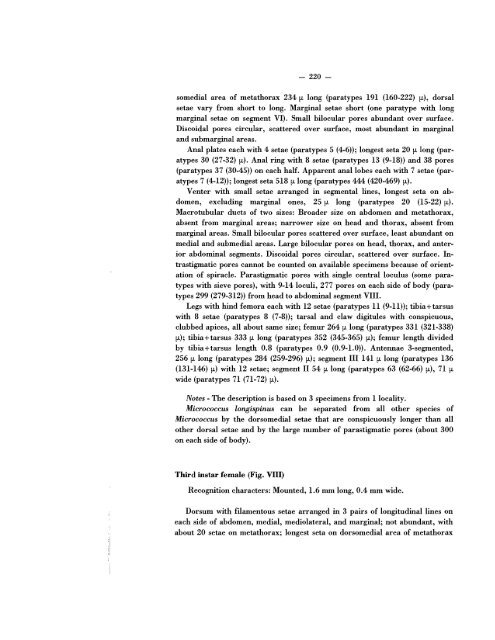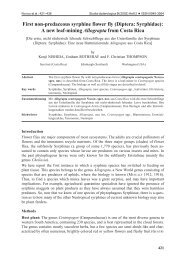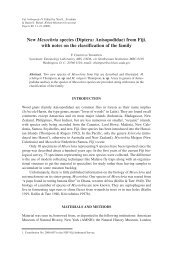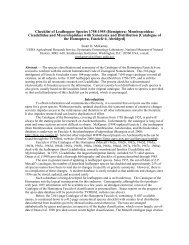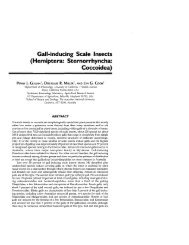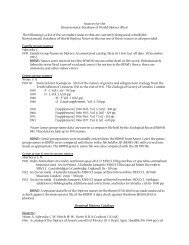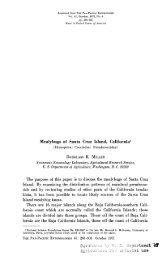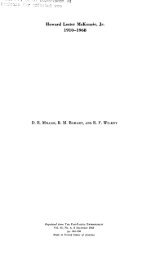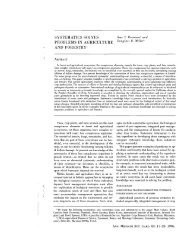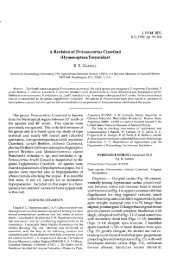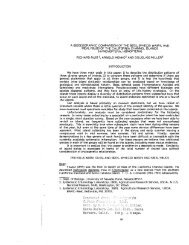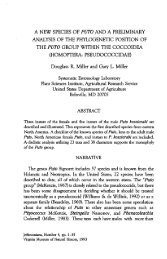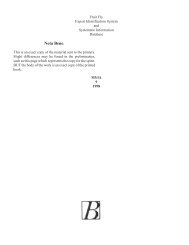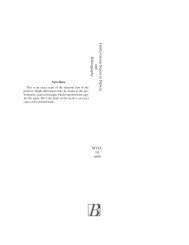Systematic revision of the Family Micrococcidae (Homoptera ...
Systematic revision of the Family Micrococcidae (Homoptera ...
Systematic revision of the Family Micrococcidae (Homoptera ...
You also want an ePaper? Increase the reach of your titles
YUMPU automatically turns print PDFs into web optimized ePapers that Google loves.
- 220 <br />
somedial area <strong>of</strong> metathorax 234 fL long (paratypes 191 (160-222) fL), dorsal<br />
setae vary from short to long. Marginal setae short (one paratype with long<br />
marginal setae on segment VI). Small bilocular pores abundant over surface.<br />
Discoidal pores circular, scattered over surface, most abundant in marginal<br />
and submarginal areas.<br />
Anal plates each with 4 setae (paratypes 5 (4-6»; longest seta 20 fL long (paratypes<br />
30 (27-32) fL). Anal ring with 8 setae (paratypes 13 (9-18» and 38 pores<br />
(paratypes 37 (30-45» on each half. Apparent anal lobes each with 7 setae (paratypes<br />
7 (4-12»; longest seta 518 fL long (paratypes 444 (420-469) fL).<br />
Venter with small setae arranged in segmental lines, longest seta on abdomen,<br />
excluding marginal ones, 25 fL long (paratypes 20 (15-22) fL).<br />
Macrotubular ducts <strong>of</strong> two sizes: Broader size on abdomen and metathorax,<br />
absent from marginal areas; narrower size on head and thorax, absent from<br />
marginal areas. Small bilocular pores scattered over surface, least abundant on<br />
medial and submedial areas. Large bilocular pores on head, thorax, and anterior<br />
abdominal segments. Discoidal pores circular, scattered over surface. Intrastigmatic<br />
pores cannot be counted on available specimens because <strong>of</strong> orientation<br />
<strong>of</strong> spiracle. Parastigmatic pores with single central loculus (some paratypes<br />
with sieve pores), with 9-14 loculi, 277 pores on each side <strong>of</strong> body (paratypes<br />
299 (279-312» from head to abdominal segment VIII.<br />
Legs with hind femora each with 12 setae (paratypes 11 (9-11»; tibia+tarsus<br />
with 8 setae (paratypes 8 (7-8»; tarsal and claw digitules with conspicuous,<br />
clubbed apices, all about same size; femur 264 fL long (paratypes 331 (321-338)<br />
fL); tibia+tarsus 333 fL long (paratypes 352 (345-365) fL); femur length divided<br />
by tibia+tarsus length 0.8 (paratypes 0.9 (0.9-1.0». Antennae 3-segmented,<br />
256 fL long (paratypes 284 (259-296) fL); segment III 141 fL long (paratypes 136<br />
(131-146) fL) with 12 setae; segment II 54 fL long (paratypes 63 (62-66) fL), 71 fL<br />
wide (paratypes 71 (71-72) fL).<br />
Notes - The description is based on 3 specimens from 1 locality.<br />
Micrococcus longispinus can be separated from all o<strong>the</strong>r species <strong>of</strong><br />
Micrococcus by <strong>the</strong> dorsomedial setae that are conspicuously longer than all<br />
o<strong>the</strong>r dorsal setae and by <strong>the</strong> large number <strong>of</strong> parastigmatic pores (about 300<br />
on each side <strong>of</strong> body).<br />
Third instar female (Fig. VIII)<br />
Recognition characters: Mounted, 1.6 mm long, 0.4 mm wide.<br />
Dorsum with filamentous setae arranged in 3 pairs <strong>of</strong> longitudinal lines on<br />
each side <strong>of</strong> abdomen, medial, mediolateral, and marginal; not abundant, with<br />
about 20 setae on metathorax; longest seta on dorsomedial area <strong>of</strong> metathorax


